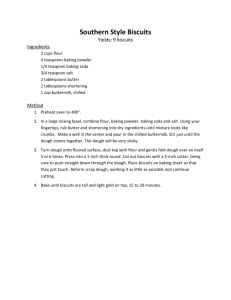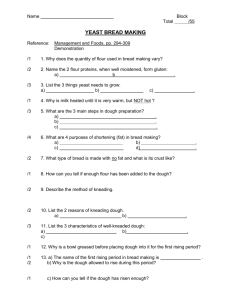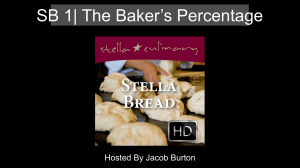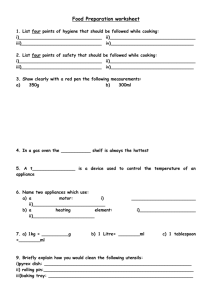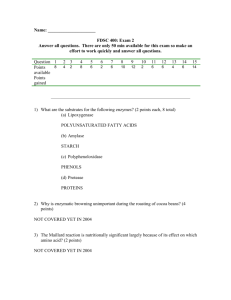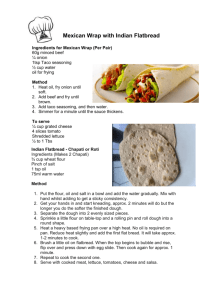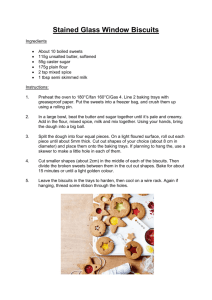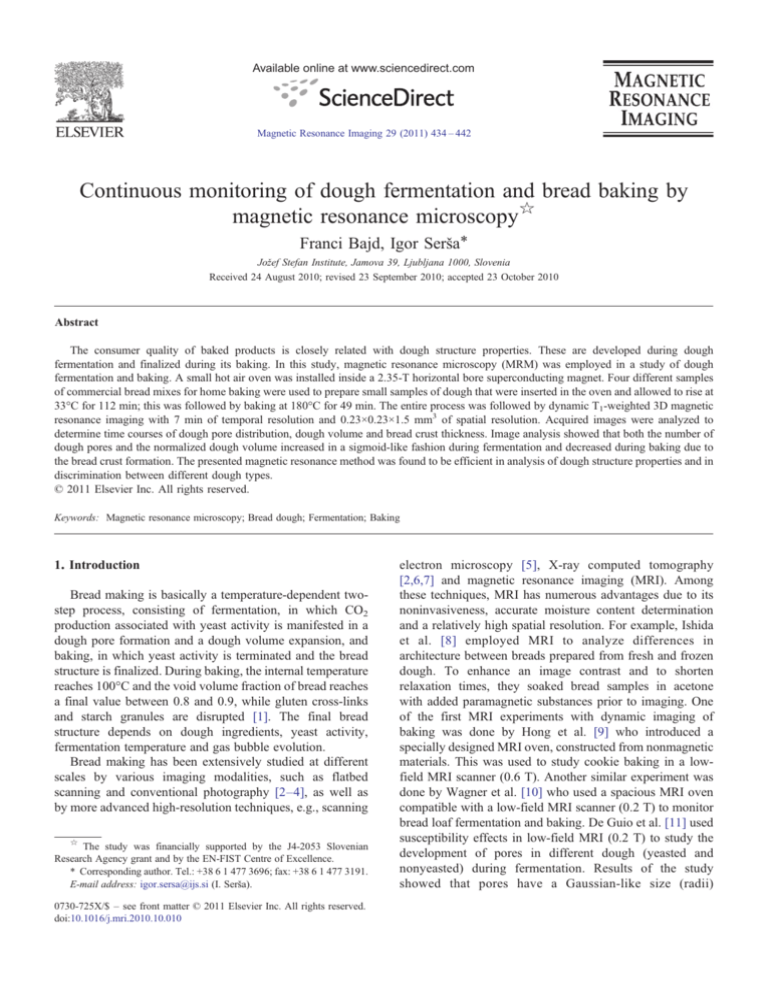
Available online at www.sciencedirect.com
Magnetic Resonance Imaging 29 (2011) 434 – 442
Continuous monitoring of dough fermentation and bread baking by
magnetic resonance microscopy☆
Franci Bajd, Igor Serša⁎
Jožef Stefan Institute, Jamova 39, Ljubljana 1000, Slovenia
Received 24 August 2010; revised 23 September 2010; accepted 23 October 2010
Abstract
The consumer quality of baked products is closely related with dough structure properties. These are developed during dough
fermentation and finalized during its baking. In this study, magnetic resonance microscopy (MRM) was employed in a study of dough
fermentation and baking. A small hot air oven was installed inside a 2.35-T horizontal bore superconducting magnet. Four different samples
of commercial bread mixes for home baking were used to prepare small samples of dough that were inserted in the oven and allowed to rise at
33°C for 112 min; this was followed by baking at 180°C for 49 min. The entire process was followed by dynamic T1-weighted 3D magnetic
resonance imaging with 7 min of temporal resolution and 0.23×0.23×1.5 mm3 of spatial resolution. Acquired images were analyzed to
determine time courses of dough pore distribution, dough volume and bread crust thickness. Image analysis showed that both the number of
dough pores and the normalized dough volume increased in a sigmoid-like fashion during fermentation and decreased during baking due to
the bread crust formation. The presented magnetic resonance method was found to be efficient in analysis of dough structure properties and in
discrimination between different dough types.
© 2011 Elsevier Inc. All rights reserved.
Keywords: Magnetic resonance microscopy; Bread dough; Fermentation; Baking
1. Introduction
Bread making is basically a temperature-dependent twostep process, consisting of fermentation, in which CO2
production associated with yeast activity is manifested in a
dough pore formation and a dough volume expansion, and
baking, in which yeast activity is terminated and the bread
structure is finalized. During baking, the internal temperature
reaches 100°C and the void volume fraction of bread reaches
a final value between 0.8 and 0.9, while gluten cross-links
and starch granules are disrupted [1]. The final bread
structure depends on dough ingredients, yeast activity,
fermentation temperature and gas bubble evolution.
Bread making has been extensively studied at different
scales by various imaging modalities, such as flatbed
scanning and conventional photography [2–4], as well as
by more advanced high-resolution techniques, e.g., scanning
☆
The study was financially supported by the J4-2053 Slovenian
Research Agency grant and by the EN-FIST Centre of Excellence.
⁎ Corresponding author. Tel.: +38 6 1 477 3696; fax: +38 6 1 477 3191.
E-mail address: igor.sersa@ijs.si (I. Serša).
0730-725X/$ – see front matter © 2011 Elsevier Inc. All rights reserved.
doi:10.1016/j.mri.2010.10.010
electron microscopy [5], X-ray computed tomography
[2,6,7] and magnetic resonance imaging (MRI). Among
these techniques, MRI has numerous advantages due to its
noninvasiveness, accurate moisture content determination
and a relatively high spatial resolution. For example, Ishida
et al. [8] employed MRI to analyze differences in
architecture between breads prepared from fresh and frozen
dough. To enhance an image contrast and to shorten
relaxation times, they soaked bread samples in acetone
with added paramagnetic substances prior to imaging. One
of the first MRI experiments with dynamic imaging of
baking was done by Hong et al. [9] who introduced a
specially designed MRI oven, constructed from nonmagnetic
materials. This was used to study cookie baking in a lowfield MRI scanner (0.6 T). Another similar experiment was
done by Wagner et al. [10] who used a spacious MRI oven
compatible with a low-field MRI scanner (0.2 T) to monitor
bread loaf fermentation and baking. De Guio et al. [11] used
susceptibility effects in low-field MRI (0.2 T) to study the
development of pores in different dough (yeasted and
nonyeasted) during fermentation. Results of the study
showed that pores have a Gaussian-like size (radii)
F. Bajd, I. Serša / Magnetic Resonance Imaging 29 (2011) 434–442
distribution with a gradually increasing average size that is
associated with the dough rise during fermentation.
All the above-presented low-field MRI experiments have
a good temporal resolution and image quality; however, they
are lacking in spatial resolution. The resolution problem can
be overcome by the use of high-field MRI scanners that
allow magnetic resonance microscopy (MRM) experiments.
One such experiment was done by van Duynhoven et al. [12]
who dynamically imaged dough fermentation using a 4.7-T
MRI scanner with a spatial resolution of 0.27×0.27×3 mm3
and a temporal resolution of 2 min. An even higher magnetic
field of 9.4 T was employed in experiments done by Bonny
et al. [13] who imaged the same process at a resolution of
0.12×0.12×0.5 mm3, but with a lower temporal resolution of
8.5 min. A similar study was done also using 3D MR
imaging with an isotropic resolution below 100 μm3 [14].
All these high-field MRI studies were constrained by
ongoing sample volume changes, so that the optimal imaging
parameters were chosen as the best compromise between the
spatial resolution and the temporal resolution, i.e., too low a
temporal resolution would result in motional blurring.
Image processing routines are a powerful tool in analysis
of dough texture properties. Standard image processing
techniques (thresholding, particle counting, area and volume
measurements) are insufficient to extract all available
information on dough fermentation and baking [8]. Therefore, advanced image processing techniques, as for example
mathematical morphology routines (dilation, erosion, closing, opening, etc.), are often used in addition to the standard
ones [2,4,13,15].
The study presented here is a continuation of previous
MRI studies on bread making and combines high-resolution
3D MRI in a high magnetic field with a sufficient temporal
resolution that enabled dynamical monitoring of the entire
process of bread making (fermentation and baking). The aim
of the study was to show that dynamic 3D MRM is a
powerful tool in analysis of bread mixes for home baking.
435
corresponding amount of water (3.25 g for mixed and seeded
bread mix and 3.5 g for white bread mix and plain flour) was
added to 5 g of bread mix or flour. The samples were
manually kneaded for 5 min, which was sufficiently long to
obtain uniform dough samples without flour clods. The
samples were then reshaped into 4.20±0.05-g round balls
(with the initial diameter of 20±1 mm) and then inserted into
an MRM oven inside the magnet. The total dough
preparation time was 9±1 min. From each bread mix (flour
type) three identical samples were made and examined by
dynamic MRM.
2.2. Dough fermentation and baking in the MRM oven
The MRM oven consisted of a nonmagnetic heater,
inserted into a thermally isolated air flow glass tube
positioned between a radiofrequency (RF) saddle coil with
an inner diameter of 25 mm and a 2-m-long plastic hose
connected to an air pump (Fig. 1). The air pump (Fisher
Scientific, Germany) provided a constant air flow with a
volume rate of 150 L/h to the heater. This was connected to a
temperature controller that regulated the heater power to
maintain the constant temperature. The hot air jet temperature was measured by a copper-constantan thermocouple
probe at the entrance to the RF coil. In order to prevent an
excessive drying of dough samples during baking the
samples were protected by a glass shield, i.e., they were
placed into a 20-mm glass test tube with the closed end
oriented towards the hot air outlet (Fig. 1). The samples
in the MRM oven were allowed to ferment for 112 min at
33°C±0.5°C which was followed by 49 min of baking at
180°C±2°C.
2.3. MRM Protocol
Dough fermentation and bread baking were dynamically
monitored with an MRI scanner consisting of a 2.35-T
(100-MHz proton frequency) horizontal bore Oxford
superconducting magnet (Oxford Instruments, Oxon, UK)
2. Materials and methods
2.1. Preparation of dough samples
Three different types of bread mixes for home baking —
mixed wheat flour, white wheat flour and wheat flour with
sesame and sunflower seeds (“Mešanica za pekovske
izdelke”, Klasje d.d, Celje, Slovenia) as well as plain
(nonyeasted) white wheat flour (Mlinotest, Ajdovščina,
Slovenia) as a control — were included in the study.
Ingredients of the mixes were as follows: mixed wheat flour
(proteins 9.4%, carbohydrates 39.7%, sugars 3.5%), white
wheat flour (proteins 9%, carbohydrates 43.5%, sugars
4.1%), seeded wheat flour (proteins 11.2%, carbohydrates
39.2%, sugars 3.9%) and plain flour (pastry wheat flour type,
proteins 4.3%, carbohydrates 81.4%, sugars 0.6%). Dough
samples were prepared at room temperature (22±0.5°C) from
the bread mixes according to the manufacturer's recipe, i.e.,
Micro-imaging
gradients
RF coil Magnet
Thermocouple
probe
Temperature
controller
Air flow
Heating coil
Dough
sample
Air pump
Glass
shield
Fig. 1. Schematic presentation of the experimental setup, i.e., the dough
sample in the MRM oven, consisting of the nonmagnetic heater inserted
between the RF coil and the air pump. A constant temperature during
fermentation (33°C) and baking (180°C) was maintained by the
temperature controller.
436
F. Bajd, I. Serša / Magnetic Resonance Imaging 29 (2011) 434–442
equipped with a Bruker micro-imaging gradient system
(Bruker, Ettlingen, Germany), with a top gradient of 250 mT/
m, using a TecMag NMR spectrometer and computer
software (TecMag, Houston, TX, USA). All MR images
were acquired with the standard 3D T1-weighted spin-echo
imaging sequence using the following imaging parameters:
echo time (TE)=3.2 ms, repetition time (TR)=200 ms, image
matrix 128×128×16 and field of view=30×30×24 mm, so
that the image resolution was 0.23×0.23×1.5 mm3. Typical
parameters for T1-weighted imaging (short TR and TE) and
no signal averaging resulted in a relatively short image scan
time of 7 min, which was still fast enough to follow breadmaking dynamics.
2.4. Image processing
Visual inspection of the acquired MR images was used to
determine a threshold value between the sample signal and
the background noise. The threshold value of the images in
the 8-bit grayscale (with pixel values ranging from 0 to 255)
was set to 50. Thresholding of the MR images was followed
by the 8-pixel connectivity operator, i.e., a binary operator
that fills all “signal holes” (regions with signals below the
threshold value that are surrounded with pixels having
signals above the threshold value) with a signal. Thus, a
mask corresponding to the dough interior was made. To
obtain the sample volume, the procedure of mask generation
was repeated for all 16 slices and pixels of each mask were
counted. The sample volume was then calculated as a
product between the number of sample voxels (sum of pixel
counts of all masks) and the voxel volume, which was equal
to 0.08 mm3 (0.23×0.23×1.5 mm3).
Crust formation was estimated based on the MR signal
loss in the crust region that contained practically no water.
The masks that corresponded to MR images acquired during
baking included only the crumb region of the bread.
Therefore the formation of the crust region during baking
was estimated as a difference between the initial mask (of the
last image of dough fermentation at t=112 min) and the
current mask (of the image of dough baking at t N112 min).
In addition, the crust thickness was estimated based on the
assumption that the dough had a spherical shape throughout
baking. Therefore, the equivalent crust thickness was
calculated as a difference between the initial radius r112
(t=112 min) and the current radius r(t) (t N 112 min) of
the dough
cðt Þ = r112
rffiffiffiffiffiffiffiffiffiffiffiffiffiffiffi
3 3 V112
− r ðt Þ =
4p
sffiffiffiffiffiffiffiffiffi!
3 VðtÞ
1−
; t N 112min;
V112
ð1Þ
where V112 and V(t) are the initial and the current dough
volumes, respectively. The equivalent bread crust thickness c(t) was then analyzed by linear-regression analysis,
i.e., c(t)=k·t+n, to obtain the equivalent bread crust
formation rate k.
The MRM images of bread making were analyzed for the
pore formation dynamics, i.e., the dough pore number was
determined throughout the entire bread-making process.
First, the dough images were inverted so that dough pores
(signal voids) became signal regions. Then, these images
were converted into binary images using the threshold value
of 225 and multiplied by the corresponding masks of the
dough interior. Isolated pixels, with intensities below the
threshold, within a pore were considered as part of the pore
(done by 8-pixel connectivity operator). Similarly, isolated
pixels, with intensities above the threshold, within the dough
region were not considered as pores and were omitted from
the dough pore analysis. Finally, the dough pore number was
obtained as a sum of pore counts from all slices. Both the
dough pore number and the normalized dough volume
during fermentation were analyzed for the best fit to the
Boltzmann sigmoidal function
yF ð t Þ =
A
+ B:
1 + expð−ðt − t0 Þ = DÞ
ð2Þ
The function parameters A and B correspond to the
amplitude and the offset, while t0 and Δ correspond to the
time lag and to the transition interval, respectively.
Mathematical morphology operations, which are conventionally used in image texture analysis, were used to obtain a
dough pore size distribution. MRM images of the central
slice relative to the samples (sixth slice out of 16) were
transformed by successive application of the closing operator
C(i) with an increasing closing element size i to obtain the
granulometric curve, i.e., an average gray level as a function
of the closing element size i. The closing operator C(i)
consists of a dilation step D(i) immediately followed by an
erosion step E(i) of the same closing element size [13]. The
effect of the closing operator is similar to a sieving operation
that removes dark objects smaller than the structuring
element and preserves the general size of larger ones.
Therefore, a granulometric curve corresponds to the size
distribution of the image particles [2]. In our analysis, a
square-like structuring element of sizes i=1…22 was used (i
corresponds to the side of the square element in pixels).
Image analysis was performed by the ImageJ (NIH, USA)
and Matlab V7.1 (MathWorks, USA) software, while the
statistical analysis was done by the Origin (OriginLab
Corporation, USA) software package. Descriptive statistics
were given as means±standard deviations.
3. Results
Fig. 2 shows dynamically acquired T1-weighted MRM
image sets of the bread-making process for four different
dough samples: three prepared from bread mixes — mixed
wheat flour (A), white wheat flour (B), wheat flour with
sesame and sunflower seeds (C) — and one from
nonyeasted, nongrained, white wheat flour (D). The first
F. Bajd, I. Serša / Magnetic Resonance Imaging 29 (2011) 434–442
437
Fig. 2. Representative dynamically acquired T1-weighted central-slice MRM images of the bread-making process for mixed flour (A), white flour (B) and seeded
flour (C) bread mix samples and for the control (nonyeasted) sample (D). The dough volume increase during fermentation is associated with the yeast activity (7–
112 min; enclosed with white lines), while the MRM signal attenuation during baking is associated with the bread crust formation (119–161 min).
five images of each set (enclosed with white lines)
correspond to dough fermentation. Comparison of the initial
(7 min) with the final (112 min) image of dough
fermentation shows an obvious dough volume increase
that is associated with dough pore formation. It can clearly
be seen that the dynamics of dough rise and pore formation
are similar for both nonseeded bread mixes (Fig. 2A and
C), while the bread mix with added seeds (Fig. 2B)
develops fewer pores per volume during fermentation due
to seed inclusions, which appear bright in T1-weighted
MRM images due to increased fat content. Nonyeasted
dough (Fig. 2D) performed quite differently; it did not rise
nor develop pores. During baking (t N112 min), yeast
activity was terminated, as well as the formation of new
pores and with it the associated dough rise. The samples
were progressively losing water in the forming crust
region, which exhibited no MR signal. The thickness of
the formed crust is proportional to dough porosity, i.e., the
438
F. Bajd, I. Serša / Magnetic Resonance Imaging 29 (2011) 434–442
crust formed on the porous dough (Fig. 2A–C) is thicker
than the curst formed on the compact dough (Fig. 2D).
Fig. 3 depicts the binary central-slice images of the dough
samples with low MR signal intensity regions (black), which
correspond to the bread crust, and with central high MR
signal intensity regions (white), which correspond to the
water-containing bread crumb and to fat-containing seeds.
The samples of all bread mixes in Fig. 3A–C have a similar
shape and dynamics to the forming bread crust; however, the
seeded bread mix in Fig. 3C differs from the nonseeded
mixes in Fig. 3A,B in a less uniform crust pattern due to
inclusion of seeds. The formation of the bread crust was
much slower in the nonyeasted plain flour sample (Fig. 3D)
due to the higher water concentration and the dough
compactness (absence of dough pores).
Results of image analyses are shown in Fig. 4 with time
dependency graphs of dough pore number (A); normalized
dough volume (B); equivalent bread crust thickness c(t); (C)
and correlation between dough pore number and normalized
dough volume (D); each graph contains the measurements of
mixed flour (blue), white flour (green) and seeded flour (red)
bread mix samples and the control sample (black). In all
bread mix samples, the dough pore number and the
normalized dough volume were gradually increasing during
fermentation in a sigmoid-like fashion, i.e., with slow
dynamics at the beginning and at the end of fermentation
and with fast dynamics in between. The best fit of the
fermentation dynamics model [sigmoidal function in Eq. (2)]
to the experimental data for the time dependency of the
dough pore number and the normalized dough volume
yielded the following model parameters: amplitude, offset,
time lag and transition interval, which are presented in
Table 1. The amplitude parameter (A) corresponds to the
maximum dough pore number or to the maximum
normalized dough volume; both maxima were reached just
immediately before baking was started. The time lag
parameter (t0) and the transition interval (Δ) were approximately identical for the dough pore number and for the
normalized dough volume, with an average value of 46±5 vs.
55±8 min (time lag) and 13±2 vs. 14±4 min (transition
interval). The nonyeasted control sample developed no pores
and therefore preserved the initial volume during fermentation. During baking, the water-containing crumb region in
the bread mix samples was shrinking due to the crust
formation, which can be seen in the decrease of normalized
dough volume (Fig. 4B). The same process is responsible for
the apparent pore loss (Fig. 4A), i.e., pores in the crust are
not detectable and are not included in the pore count.
Analyzed crumb volumes during baking enabled calculation
of the equivalent crust thickness as a function of the baking
time (c(t), Eq. (1)). This was followed by the linear
regression analysis in Fig. 4C, which yielded the equivalent
bread crust formation rates k equal to 0.12±0.01, 0.13±0.01
and 0.12±0.01 mm/min for mixed flour, white flour and
seeded flour bread mixes (R2N0.99), respectively, and 0.03±
0.01 mm/min for the control sample (R2N0.92). The graph in
Fig. 4D depicts a correlation between the dough pore number
and the normalized dough volume. This is linear and positive
in all the bread mix samples with the Pearson correlation
coefficient close to unity (rxy=0.98±0.01 in fermentation and
Fig. 3. Binary central-slice images of the bread crust formation during baking for mixed flour (A), white flour (B) and seeded flour (C) bread mix samples and for
the control (nonyeasted) sample (D). Dark regions correspond to the bread crust, while white regions surrounded by the dark crust correspond to the watercontaining bread crumb and to fat-containing seeds. A nonuniform crust formation is associated with the temperature gradient established along the MRM oven.
The void arrow indicates the direction of the hot air jet.
F. Bajd, I. Serša / Magnetic Resonance Imaging 29 (2011) 434–442
439
Fig. 4. Time dependency graphs of dough pore number (A), normalized dough volume (B) and equivalent bread crust thickness (C) as well as the correlation
graph of normalized dough volume vs. dough pore number (D) for mixed flour (blue), white flour (green) and seeded flour (red) bread mix samples and for
the control (nonyeasted) sample (black). The dough pore number (A) and the normalized dough volume (B) of the yeasted dough samples increased with
time in a sigmoid-like fashion (Eq. (2)) during fermentation and decreased during baking due to the linear increase of the bread crust thickness (C). The
normalized dough volume is in linear and positive correlation with the dough pore number (D) for the bread mix samples; no correlation is found for the
control sample. The dashed vertical line in (A) to (C) denotes the last fermentation step (t=112 min), whereas the dashed horizontal line in (B) corresponds to
the initial normalized dough volume.
rxy=0.99±0.01 in baking). No correlation between the dough
pore number and the normalized dough volume was found in
the nonyeasted control sample (rxy=−0.55).
Graphs of granulometric curves in Fig. 5 were obtained
by application of the closing operator on the central-slice
MRM images during fermentation (t=7, 49, 105 min) and
Table 1
Best fit parameters of dough pore number and normalized dough volume, as
obtained by analysis with the Boltzmann sigmoidal function (Eq. (2))
Flour type
A
B
t0 (min)
Δ (min)
R2
Dough pore number
Mixed flour bread mix
White flour bread mix
Seeded bread mix
Plain white flour
498±15
496±14
298±4
78±4
0
0
0
0
46±2
51±1
42±1
128±1
15±1
14±1
11±1
5±1
0.99
0.99
N0.99
0.97
Normalized dough volume
Mixed flour bread mix
White flour bread
Seeded bread mix
Plain white flour
0.80±0.01
0.89±0.03
0.50±0.01
–
1
1
1
–
47±1
62±1
57±1
–
13±1
17±1
13±1
–
N0.99
N0.99
N0.99
–
baking (t=147 min). The graphs present the dough pore
distribution of all the examined samples: mixed flour (A),
white flour (B) and seeded flour (C) bread mix samples and
of the control sample (D). With an increasing time of
fermentation, the pore distributions of all bread mix samples
indicate a progressive increase of pore sizes with the
fermentation time. This can be seen in the graphs as a shift
of the average pore size towards larger closing sizes, i.e., a
proportion of smaller pores are decreasing on account of an
increasing proportion of larger pores. During baking, pore
geometry and size distribution were changed, which can be
seen as a shift of the average pore area towards smaller
closing sizes. The granulometric curve of the nonyeasted
control sample remained practically unchanged during both
fermentation and baking (Fig. 5D).
4. Discussion
The principal findings of this work are that high spatialand temporal-resolution 3D MRM can be performed in high-
440
F. Bajd, I. Serša / Magnetic Resonance Imaging 29 (2011) 434–442
Fig. 5. Granulometric curves during fermentation (t=7, 49 and 105 min) and baking (t=147, void symbols) for mixed flour (A), white flour (B) and seeded flour
(C) bread mix samples and for the control (nonyeasted) sample (D). The curves of all bread mix samples indicate that the pore size increased with time, while the
control (nonyeasted) sample remained unchanged.
temperature conditions (in an MRM-compatible oven) that
allow continuous monitoring of the bread-making process.
The dynamically acquired 3D T1-weighted images provide a
detailed insight into the bread dough structure which can be
analyzed further by means of mathematical morphology and
thresholding operations. These enable relevant information
about dough pore parameters (volume, size distribution,
structure, connectivity, etc.) to be used in the development of
more efficient baking ingredients and processes.
The quality of MRM images, i.e., its signal-to-noise ratio
(SNR), was limited by the need for a reasonable spatial and
temporal resolution. In our experiments, where the conventional 3D T1-weighted spin-echo imaging sequence was
used, the scan time of 7 min and the spatial resolution of
0.23×0.23×1.5 mm3, which yielded MRM images with an
SNR of 10, were found to be a reasonable compromise
between image quality and spatial and temporal image
resolution. The temporal resolution of 7 min was high
enough to avoid motion blurring in MRM images of dough
fermentation. Another resolution problem is associated with
slice thickness. Pores may be bigger than the slice thickness
and in that case the same pore may appear in several slices. If
they are smaller than the slice thickness, then pores may
overlap in the slice and two or more pores may appear as one
larger pore. In both cases, errors are made in pore counting,
i.e., the large pores are counted more than once, while some
of the small ones are not counted at all. In the study, the slice
thickness was 1.5 mm, which is in the mid range of pore
sizes. Thinner slices could be obtained by using a larger
imaging matrix (for example 128×128×32); however, this
would prolong the scan time. Another option would be to use
another 3D imaging technique, as for example 3D RARE
[16], which can acquire multiple k-space signal lines in one
signal excitation.
The fermentation and baking temperature (33°C and
180°C, respectively) were chosen to mimic the breadmaking conditions of a typical bread machine [17]. During
fermentation, bread mix samples inflated due to a favorable
temperature condition (33°C) for the yeast activity, which
was manifested in CO2 production and with it the associated
dough pore formation. Dough rise was initially unobstructed
and was later (at fermentation times t N70 min) obstructed
due to the 20-mm glass shield surrounding the dough
sample, which imposed a cylindrical shape rise of the dough
samples (Fig. 2). A consequence of the heat dissipation in the
MRM oven is the negative temperature gradient along the air
jet. This is associated with a nonuniform dough rise in the
MRM oven during fermentation as well as with a
nonuniform MR signal decrease during baking (180°C).
Both dough rise and the MR signal decrease are more intense
F. Bajd, I. Serša / Magnetic Resonance Imaging 29 (2011) 434–442
at the hot air inlet to the oven than at its outlet (Fig. 2). The
same effect is quite apparent also in the study of the crust
formation dynamics in Fig. 3 which shows again a
nonuniform crust formation; the crust is thicker at the hot
air inlet to the MRM oven than at its outlet. The temperature
gradient inside the MRM oven can be reduced by the use of
several hot air inlets uniformly distributed over the MRM
oven or, alternatively, of more elaborate hot air paths that
uniformly heat oven walls [10].
The time course of the dough pore number (Fig. 4A) and
the normalized dough volume (Fig. 4B) of all dough samples
during fermentation was modeled with the Boltzmann
sigmoidal function (Eq. (2)), which is often used to describe
growth in biological systems [18]. The dough pore number
and the normalized dough volume were positively correlated, which is quite apparent from the correlation graph in Fig.
4D and from corresponding correlation coefficients that are
close to unity. The sudden increase in dough pore number
(Fig. 4A) and the normalized dough volume (Fig. 4B) in the
last fermentation step (t=112 min) can be attributed to the
increased yeast activity induced by a sudden temperature rise
at the baking start. However, when the final baking
temperature was established, the yeast activity and the
dough rise stopped. This can be confirmed by MRM images
of the seeded sample in which seeds kept their initial
positions during baking, as can be clearly seen in Fig. 2B
(119–161 min).
A water concentration-based criterion (MR signal thresholding), which was used to determine the time course of the
bread crust formation, was perhaps not optimal as it may
result in an overestimated crust thickness (Fig. 4C). Visually,
crust is defined by the change of the dough color from white
(crumb) to brown (crust), which normally occurs in a region
that is thinner than the dehydrated region on the dough
surface. Formation of the crust is associated with the weight
loss of the dough samples due to the evaporated water in
baking. The dough samples were weighted before and after
the bread-making process. The average mass of the dough
samples after baking was reduced to 57%±1% (nonseeded)
and 60%±1% (seeded) of the initial mass (4.20±0.05 g).
The largest increase in the dough pore number (Fig. 4A)
and the normalized dough volume (Fig. 4B) occurred in the
nonseeded bread mix samples. The increase was somewhat
lower in the seeded bread mix sample due to a lower amount
of yeast per dough volume due to the added seeds. As
expected, pores were not formed during fermentation in the
control (nonyeasted) sample. However, it is interesting that
pores were appearing in the sample during baking (t N128
min). The origin of the pores may be the thermal expansion
of gases in the sample associated with water evaporation.
5. Conclusion
This study demonstrates that MRM can provide an insight
into processes that require extreme temperature conditions.
441
The method was presented by a series of dynamic 3D MRM
experiments that mimicked home bread baking. It was
shown that the acquired MR images provide useful
information on dough structure, yeast activity, crust
formation and optimal baking time. However, the same
method can be applied to a large variety of other food
products with a similar preparation method. The information
provided by the method can help optimize food preparation
processes and is useful in development and characterization
of new food products.
Acknowledgments
The authors thank to Ana Sepe and Davorin Kotnik for
technical assistance.
References
[1] Bloksma AH. Dough structure, dough rheology, and baking quality.
Cereal Foods World 1990;35(2):237–44.
[2] Lassoued N, Babin P, Della Valle G, Devaux MF, Reguerre AL.
Granulometry of bread crumb grain: contributions of 2D and 3D image
analysis at different scale. Food Res Int 2007;40(8):1087–97.
[3] Rogers DE, Day DD, Olewnik MC. Development of an objective
crumb-grain measurement. Cereal Foods World 1995;40(7):498–501.
[4] Rouille J, Della Valle G, Devaux MF, Marion D, Dubreil L. French
bread loaf volume variations and digital image analysis of crumb grain
changes induced by the minor components of wheat flour. Cereal
Chem 2005;82(1):20–7.
[5] Hayman D, Hoseney RC, Faubion JM. Bread crumb grain development during baking. Cereal Chem 1998;75(5):577–80.
[6] Babin P, Della Valle G, Chiron H, Cloetens P, Hoszowska J, Pernot P,
et al. Fast X-ray tomography analysis of bubble growth and foam
setting during breadmaking. J Cereal Sci 2006;43(3):393–7.
[7] Falcone PM, Baiano A, Zanini F, Mancini L, Tromba G, Dreossi D,
et al. Three-dimensional quantitative analysis of bread crumb by X-ray
microtomography. J Food Sci 2005;70(4):E265–72.
[8] Ishida N, Takano H, Naito S, Isobe S, Uemura K, Haishi T, et al.
Architecture of baked breads depicted by a magnetic resonance
imaging. Magn Reson Imaging 2001;19(6):867–74.
[9] Hong SW, Yan ZY, Otterburn MS, McCarthy MJ. Magnetic resonance
imaging (MRI) of a cookie in comparison with time-lapse photographic analysis (TLPA) during baking process. Magn Reson Imaging
1996;14(7–8):923–7.
[10] Wagner MJ, Loubat M, Sommier A, Le Ray D, Collewet G, Broyart B,
et al. MRI study of bread baking: experimental device and MRI signal
analysis. Int J Food Sci Technol 2008;43(6):1129–39.
[11] De Guio F, Musse M, Benoit-Cattin H, Lucas T, Davenel A. Magnetic
resonance imaging method based on magnetic susceptibility effects to
estimate bubble size in alveolar products: application to bread dough
during proving. Magn Reson Imaging 2009;27(4):577–85.
[12] van Duynhoven JPM, van Kempen GMP, van Sluis R, Rieger B,
Weegels P, Vliet LJ, et al. Quantitative assessment of gas cell
development during the proofing of dough by magnetic resonance
imaging and image analysis. Cereal Chem 2003;8(4):390–5.
[13] Bonny JM, Rouille J, Della Valle G, Devaux MF, Douliez JP, Renou
JP. Dynamic magnetic resonance microscopy of flour dough
fermentation. Magn Reson Imaging 2004;22(3):395–401.
[14] Takano H, Naito S, Ishida N, Koizumi M, Kano H. Fermentation
process and grain structure of baked breads from frozen dough using
freeze-tolerant yeasts. J Food Sci 2002;67(7):2725–33.
[15] Rouille J, Bonny JM, Della Valle G, Devaux AF, Renou JP. Effect of
flour minor components on bubble growth in bread dough during
442
F. Bajd, I. Serša / Magnetic Resonance Imaging 29 (2011) 434–442
proofing assessed by magnetic resonance imaging. J Agric Food Chem
2005;53(10):3986–94.
[16] Hennig J, Nauerth A, Friedburg H. RARE imaging: a fast imaging
method for clinical MR. Magn Reson Med 1986;3(6):823–33.
[17] Schober TJ, Bean SR, Boyle DL. Gluten-free sorghum bread
improved by sourdough fermentation: biochemical, rheological, and
microstructural background. J Agric Food Chem 2007;55(13):
5137–46.
[18] De Carvalho JC, Pandley A, Oishi BO, Brand D, Rodrigues-Leon JA,
Soccol CR. Relation between growth, respirometric analysis and
biopigments production from Monascus by solid-state fermentation.
Biochem Eng J 2006;29(3):262–9.

